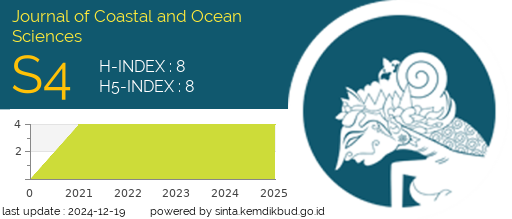Isolation and Identification of Bacteria from Dumai Marine Waters that Have Potencial as Lead Bioremediation Agents
DOI:
https://doi.org/10.31258/Keywords:
Bacteri bioremediation Dumai PollutionAbstract
One of the harmful pollutants to human health is the heavy metal Lead (Pb). A high concentration of lead that has can accumulate in the body of living things if in a long period of time. Lead concentrations that exceed the threshold in an environment can cause damage that affects aquatic biota and other living things. This research was carried out in February-April 2021. The purpose of this study was to isolate and identify bacteria that have the potential as lead bioremediation agents from Dumai marine waters. Isolation and identification of bacteria were carried out at the Laboratory of Marine Microbiology, Department of Marine Science, Faculty of Fisheries and Marine Sciences, and the lead concentration test at the Laboratory of Chemical Testing and Analysis, Department of Chemical Engineering, Faculty of Engineering. The results of the isolation on Marine Agar media which was added with Pb acetate (Pb(CH3COO2)) obtained three bacterial isolates from Dumai sea waters, namely D1, D2, and D3. The isolate that had the best growth was isolated D1. The isolate D1 was able to reduce the highest Pb concentration from 10 ppm by 80.53%, at a concentration of 20 ppm Pb, the isolate D1 was able to reduce Pb concentration by 78.8% and at a concentration of Pb 30 ppm, isolate D1 was able to reduce Pb concentration by 77.21%.
Downloads
References
Chihomvu P., P. Stegmann, dan M. Pillay. (2014). Identification and Characterization of Heavy Metal Resistant Bacteria from the Klip River. International J Biol Biomol Agri Food Biotechnol Enginee 8(11): 1178-1188.
Dalynn, B. (2014). McFarland Standard. Canada: Dalynn Biological.
Hadioetomo, R.S. (1993). Mikrobiologi Dasar dalam Praktek Teknik dan Prosedur Dasar Laboratorium. PT. Gramedia Pustaka Utama.
Haris, A., Arniati, dan S. Werorilangi. (2013). Uji Antibakteri Patogen Ekstrak Sponge Menggunakan Metode High Troughput Screening (HTS) dengan indikator MTT (3-[4,5-dimethylthiazol-2-yl]-2,5-diphenyltetrazolium bromide). Jurusan Ilmu Kelautan, FIKP, UNHAS.
Harley, J.P. dan L.M. Prescott. (2002). Laboratory Exercises in Microbiology. Fifth Edition. The McGraw−Hil.
Holt, J.G., N.R. Krig, P.H.A. Snearth, J.T. Staley, dan S.T. Williams. (1994), ‘Bergey’s Manual of Determinative Bacteriology 9th Edition’: Lipincott Williams and Wilkins Company, Philadelphia (USA).
Juniawan A., B. Rumhayati dan B. Lamuyanto. (2013). Karakteristik Lumpur Lapindo dan Fluktuasi Logam Berat Pb dan Cu pada Sungai Porong dan Aloo. Jurnal Sains dan Terapan Kimia 7(1) : 1-10.
Junopia, A.C. (2015). Isolasi dan Identifikasi Bakteri Pendegradasi Logam Timbal (Pb) yang Bersumber dari Danau Tempe Kabupaten Wajo Sulawesi Selatan. Skripsi. Fakultas Sains dan Teknologi. UIN Alauddin Makassar.
Lewaru, S., R. Indah. dan M. Yuniar. (2012). Identifikasi Bakteri Indigeneus Logam Berat Cr (VI) dengan Metode Molekuler di Sungai Cikijing Rancaekek Jawa Barat. Jurnal Perikanan dan Kelautan, 3(4) : 81-92.
Priadie, B. (2012). Teknik Bioremediasi Sebagai Alternatif dalam Upaya Pengendalian Pencemaran Air. Jurnal Ilmu Lingkungan, 10(1): 38-48.
Satya, A., dan S. Larashati. (2012). Kemampuan Isolat Bakteri dari Sedimen Situ Sebagai Aquatic Bioremoval Agent Ion Logam Timbal (Pb). Prosiding Seminar Nasional Limnologi IV 19: 50-60.
Usman, S., L.N. Nafie, dan M. Ramang. (2013). Distribusi Kuantitatif Logam Berat Pb dalam Air, Sedimen dan Ikan Merah (Lutjanus erythropterus) di Sekitar Perairan Pelabuhan Parepare. Marina Chimica Acta, 14(2):1411-2132.






